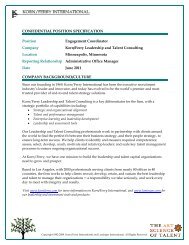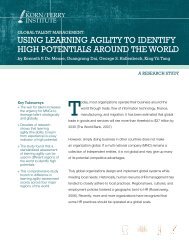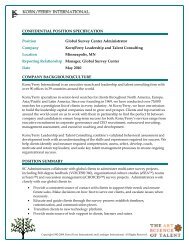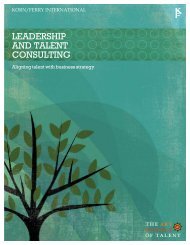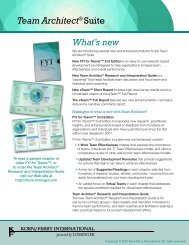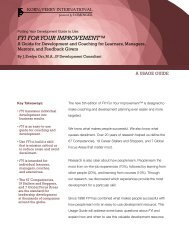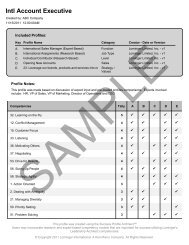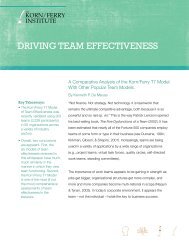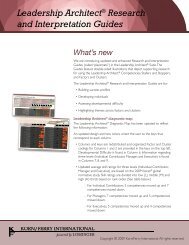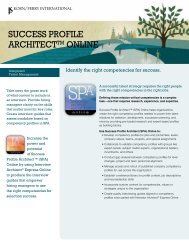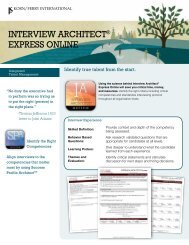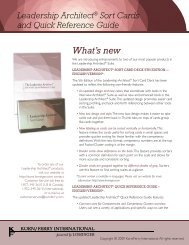understanding and applying tools to identiFy and ... - Lominger
understanding and applying tools to identiFy and ... - Lominger
understanding and applying tools to identiFy and ... - Lominger
You also want an ePaper? Increase the reach of your titles
YUMPU automatically turns print PDFs into web optimized ePapers that Google loves.
2. How long does it take <strong>to</strong> develop learning agility?This depends both on how much development needs <strong>to</strong> takeplace <strong>and</strong> how difficult a particular dimension is <strong>to</strong> develop. Ingeneral, learning agility is not something that is developed quicklyor easily, in part because experience itself plays a critical role.As a rule of thumb, allow nine months or so for a particular jobexperience <strong>to</strong> yield some substantive lessons <strong>and</strong> roughly anequal amount of time <strong>to</strong> gain experience with <strong>applying</strong> thoselessons <strong>to</strong> new challenges.There is not a “one bestexperience” for developinglearning agility overallor even for a particulardimension or fac<strong>to</strong>r.Generally, there are manyoptions <strong>to</strong> choose from,both part-time <strong>and</strong> full-timeexperiences.3. How much can I expect <strong>to</strong> develop my learning agility?This depends on where you are now in terms of your skill level<strong>and</strong> how far you are looking <strong>to</strong> progress. If you were <strong>to</strong> giveyourself the equivalent of a letter grade in learning agility, it isreasonable that you might be able <strong>to</strong> move up one letter gradein skill over time. In general, the further advanced you already arein your learning agility, the better your prospects for continueddevelopment, in part because you show a strong tendency<strong>to</strong>wards growth <strong>and</strong> adaptability. Put another way, someonewho is a high performer but low in learning agility is not likely<strong>to</strong> transform in<strong>to</strong> a true high potential. It is better <strong>to</strong> emphasizecontinued growth in the areas where he or she alreadydemonstrates some comfort <strong>and</strong> expertise.4. What are the best experiences for developing learning agility?There is not a “one best experience” for developing learningagility overall or even for a particular dimension or fac<strong>to</strong>r.Generally, there are many options <strong>to</strong> choose from, both parttime<strong>and</strong> full-time experiences. FYI for Learning Agilityhighlights a number of specific experiences that provide goodopportunities for development for each learning agility dimension.The determination of which experience might provide the bes<strong>to</strong>pportunity should be a decision between the individual looking<strong>to</strong> develop <strong>and</strong> his or her coach.14Getting the Most out of Learning Agility in Your OrganizationOur intent with this Usage Guide is <strong>to</strong> provide you with an informativeoverview of the <strong><strong>to</strong>ols</strong> available for identifying <strong>and</strong> developing learningagility in your organization. Applied correctly, they will help <strong>to</strong> unlockthe sources of potential in your organization <strong>and</strong> establish a strong <strong>and</strong>enduring pipeline of future leaders.



